Curlew - 2019 WeBS
 Tuesday, March 31, 2020 at 9:12AM
Tuesday, March 31, 2020 at 9:12AM 
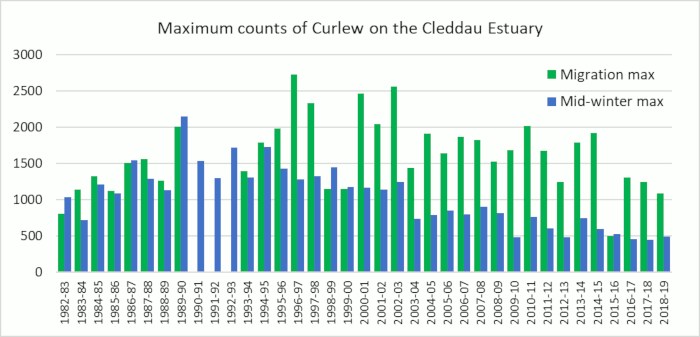

 Pembrokeshire Avifauna committee | Comments Off |
Pembrokeshire Avifauna committee | Comments Off |  Tuesday, March 31, 2020 at 9:12AM
Tuesday, March 31, 2020 at 9:12AM 


 Tuesday, February 25, 2020 at 9:29AM
Tuesday, February 25, 2020 at 9:29AM
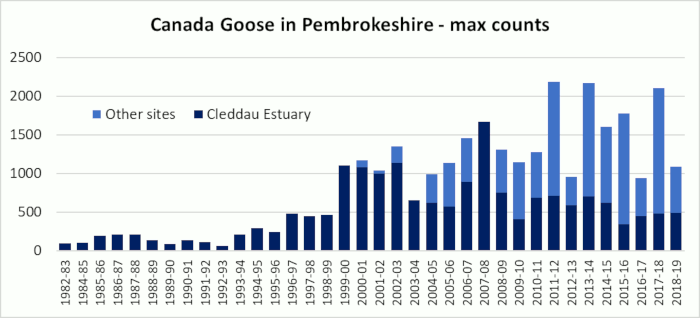 The peak of 1669 on the Cleddau occurred in June 2007. The peak during the 'normal' count season of September to March was 651 in December that year. During the 2010s, the peak count on the Cleddau has been in June or July.
The peak of 1669 on the Cleddau occurred in June 2007. The peak during the 'normal' count season of September to March was 651 in December that year. During the 2010s, the peak count on the Cleddau has been in June or July.
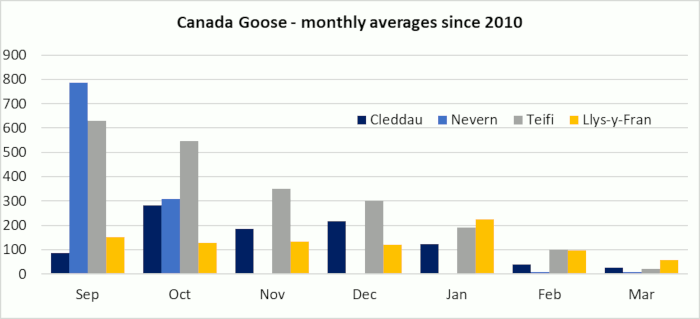
Canada Geese did not appear regularly in WeBS counts on the Nevern Estuary until 2003-04. Maximum counts of between 1250 and 1500 have occurred several times in September-October since 2013-14. Counts are still low outside of this period, with none recorded in November-January, although there have been occasional counts of less than a dozen in mid-winter on non-count days.
Counts on the Teifi Estuary have numbered in the 100s since 2000, steadily increasing to 1000 in September 2010-11. Since then, there have been several counts of over 1000, all in the September-November period. It is possible that these are birds that were at the Nevern earlier in the season.
Generally small numbers (less than 50) occur on fresh-water sites. However they are more regular on LLys-y-Fran (up to 400) and on Marloes Mere (370 in 2010-11 but more usually less than 100).
Counts of Canada Geese can be surprisingly low at any site due to their habit of moving away to feed in fields, often some distance from the water, during the day.
National trend
The WeBS national trend for Canada Goose show a massive increase in the Welsh population in the late 1990s, however the overall British trend showed only a slow increase at that time. The English popluation remained relatively stable, suggesting that a part of the increasing population has moved to Wales.
Canada geese across Britain have shown a typical population curve of a “new” species, whether introduced by man or by natural expansion. Initially they remained at a relatively low level as the population established itself, followed by a rapid rise, and then (since around 2000) a levelling out as the population reaches the maximum carrying capacity of the habitat.
As the numbers of geese have increased, they have increasingly fed away from the estuary and are often missed during a count. This may account for a low peak number in some years, and it is difficult to know if this is a true indication of the population change, or just half the birds being elsewhere.
Are they causing a problem?
Some studies have been undertaken in other parts of the country regarding their effect on other wild birds using the same water bodies. This research suggests that even large numbers of Canada geese have no effect on other species of wildfowl. The increased population on the Cleddau does not, at present, appear to be having any effect on the overall numbers of wildfowl in the areas they occur. However, there may be an effect on the vegetation from trampling and eutrophication.
 Goose,
Goose,  WeBS,
WeBS,  wildfowl in
wildfowl in  Canada Goose
Canada Goose  Saturday, February 22, 2020 at 6:01PM
Saturday, February 22, 2020 at 6:01PM Brent geese were occasional visitors to Pembrokeshire before 1990, and only began to appear regularly on WeBS counts in1993-94 as shown below.
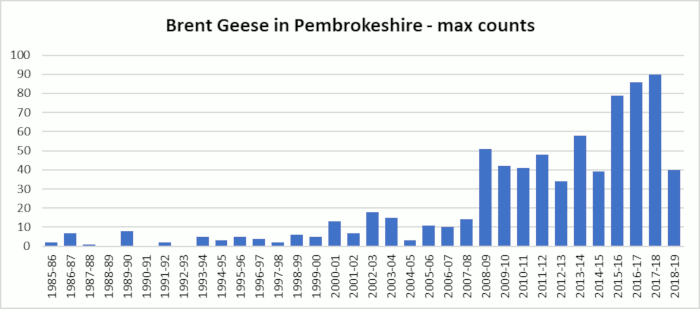
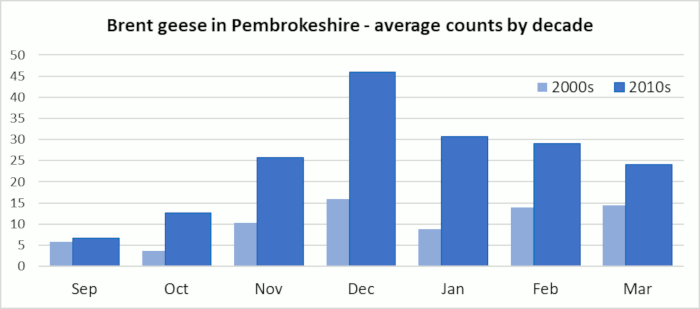
The highest numbers in any season are recorded between December and February
Almost all brent geese are seen on the Cleddau, especially at the Gann or at Angle Bay. Just a handful are counted on the Nevern and Teifi.
As the birds commute - either in a flock, or in small groups - between the Gann and Angle Bay - it is possible that they can be double-counted at times. However, an individual count of 77 at Angle Bay in December 2016, (and other individual counts - 68 at the Gann in 2012 and 62 at Angle Bay in 2017 - on non-WeBS days) that suggest the WeBS totals are reasonable.
Almost all birds are of the light-bellied race (hrota) - with just a handful of dark-bellied birds recorded.
Many ringed birds have been observed, and these prove movements between Ireland (main ringing station), Pembrokeshire and Brittany, and to north-east Canada (breeding grounds) via Iceland and Greenland.
AH
Pembrokeshire WeBS coordinator
 WeBS,
WeBS,  wildfowl,
wildfowl,  winter in
winter in  Brent Goose
Brent Goose  Tuesday, January 26, 2016 at 12:27PM
Tuesday, January 26, 2016 at 12:27PM Maximum winter counts from all sites counted for the Wetland Bird Survey in Pembrokeshire. Data after 2000 includes the Teifi Estuary.
Main wintering sites for this species are the Bosherston Lakes, South Hook Pools, Llys-y-fran and Rosebush Reservoirs and Pembroke Millponds. Bicton Reservoirs was a major wintering site, but has not been used much by coot since 2000.
The dramatic decline of the last four seasons reflects the trend across Wales, and Britain as a whole.
The Welsh Bird Report for 2014 suggests there are indications of a severe decline in breeding numbers in several western counties in recent years and wintering numbers have also declined at several sites.
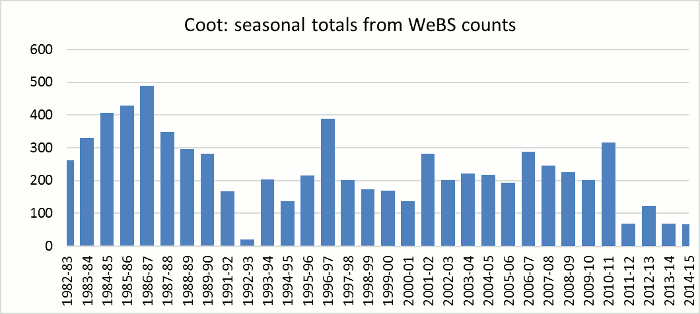
 Tuesday, January 26, 2016 at 11:55AM
Tuesday, January 26, 2016 at 11:55AM Maximum winter counts from all sites counted for the Wetland Bird Survey in Pembrokeshire. Data after 2000 includes the Teifi Estuary.
Main wintering sites for this species are the Cleddau Estuary, Bosherston Lakes, and Llys-y-fran Reservoir. However, large numbers can occur elsewhere, for example 50-60 in Fishguard Harbour in early 2015.
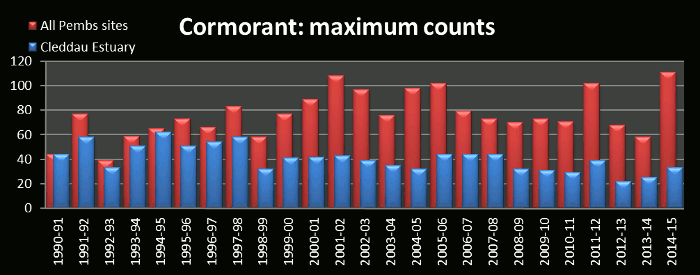
 Wednesday, January 1, 2014 at 12:04PM
Wednesday, January 1, 2014 at 12:04PM Shelduck in Pembrokeshire winter mainly on the Cleddau Estuary, with a few being recorded on the Teifi and Nevern Estuaries, and one or two occasionally on fresh-water sites.

In the 1980s birds would typically start arriving in November, with about a thousand present by January. These stayed until March, when numbers fell rapidly as birds moved back to their breeding grounds or moulting grounds. During the 1990s numbers built up steadily from October to a peak in January, then fell steadily. The peak counts were slightly lower than in the 1980s, and this was generally thought to be due to milder winters allowing birds to return earlier to more northerly areas. The GB national index remained reasonably steady during this time, suggesting that the population overall was not declining.
In the late 1990s the GB index fell slightly, but has now levelled out again. However, the numbers on the Cleddau have continued to decline and were below the level of national importance during the early 2000s. Numbers on the Burry Inlet also fell at this time. Outside of Wales, Poole Harbour, for example, has experienced a decline of about 60% in recent years (Musgrove, 2007). Not surprisingly the threshold has now been lowered, but the Cleddau system still only barely qualifies on a five-year average peak count.
The change in timing of birds arriving and departing the Cleddau may be linked to the recent run of mild winters, and to an increase in protected areas on the continental mainland.
Adult birds move from their wintering grounds to the breeding grounds and from there to moulting grounds in mid-late summer (Wernham, 2002). Young birds may move more slowly towards the moulting grounds. The locations used for moult may be changing, for example, most birds went to the Helgoland Bight in the German Waddensee, but in recent years the numbers of birds on British moulting grounds such as the Wash, Bridgewater Bay and the Dee/Mersey estuary have been increasing. The change in distances travelled may influence the timing of birds arriving back in their wintering grounds. There has been one ringing recovery showing movement of a bird between Pembrokeshire and the Waddensee, but are they still going there? These changes in moulting grounds may be linked to increasing numbers of shelduck breeding in Ireland.
There is no indication of any changes in food supply or other environmental factors on the estuary system that would explain observed trends.
Annie Haycock
Pembrokeshire WeBS coordinator
 Thursday, November 24, 2011 at 8:36PM
Thursday, November 24, 2011 at 8:36PM
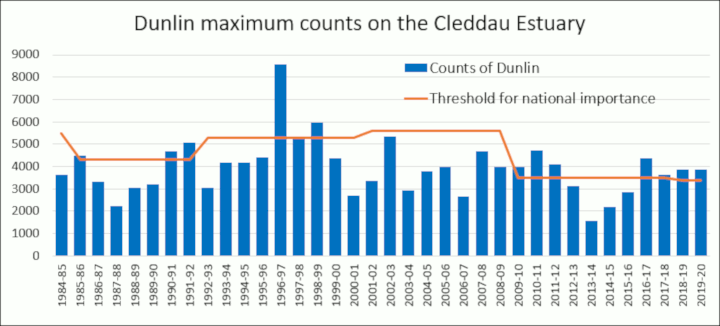 Peak counts of dunlin are erratic, but generally in the range of 2,500 to 5,000 birds. Numbers were higher on average in the 1990s, including a peak of some 8,500 birds in 1996-97 which mirrored an influx seen across the whole UK in that year only. Numbers have been lower since 2000-01.
Peak counts of dunlin are erratic, but generally in the range of 2,500 to 5,000 birds. Numbers were higher on average in the 1990s, including a peak of some 8,500 birds in 1996-97 which mirrored an influx seen across the whole UK in that year only. Numbers have been lower since 2000-01.
To be of national importance for a species, a site must hold a five-year average count above the threshold level. With numbers fluctuating widely, the Cleddau occasionally achieves this figure
Most of the dunlin on the Cleddau are found on the large open mudflats of Pembroke River, Carew-Cresswell and Hook-Sprinkle. Decadal averages indicate that most of the decline has occurred on the Pembroke River and the Carew-Cresswell.
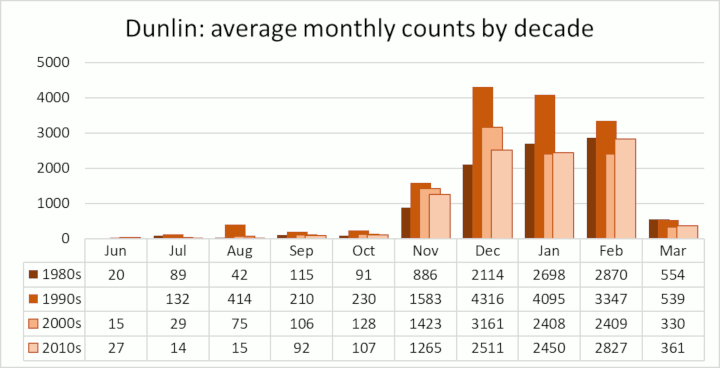
Very few dunlin are counted on other Pembrokeshire WeBS sites - usually around 200 on the Nevern and Teifi combined, occasionally nearer 300.
Monthly indices show that, throughout the UK, numbers are now generally lower all through most of the winter. This is mirrored by a rise in the Netherlands, strongly suggesting that birds migrating from the northeast, and possibly northwest, are stopping on the Wadden Sea. This may be a consequence of the milder weather of recent winter. Previously, in October, after moulting on the Wash & Waddensee, many birds moved westwards to areas of milder winter climate. Between February and April, many birds move east again before migrating to breeding grounds.
Annie Haycock, WeBS Review 2020